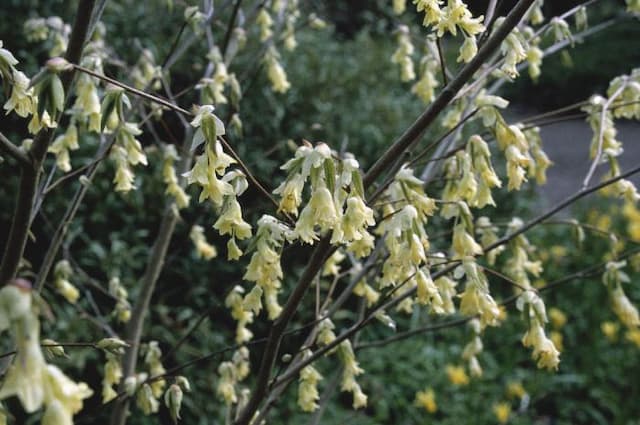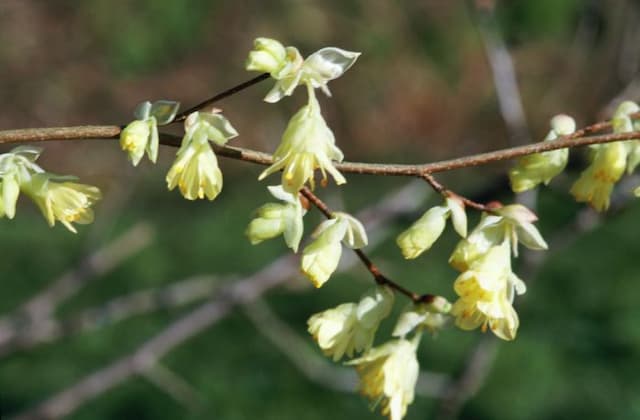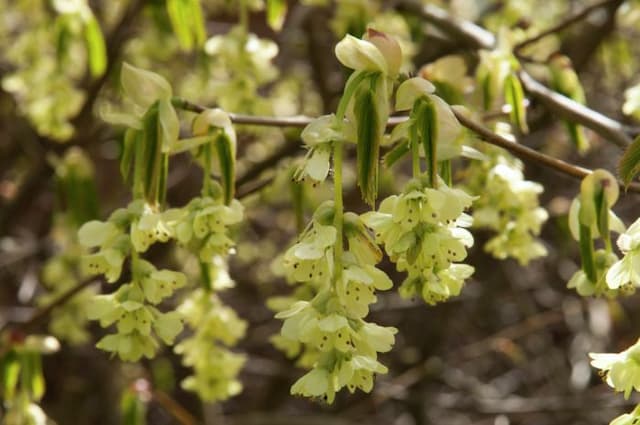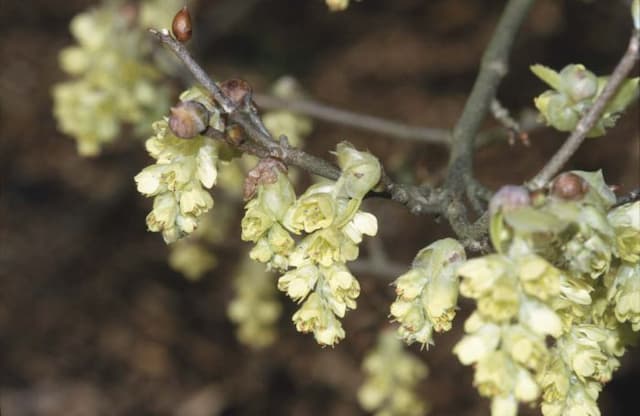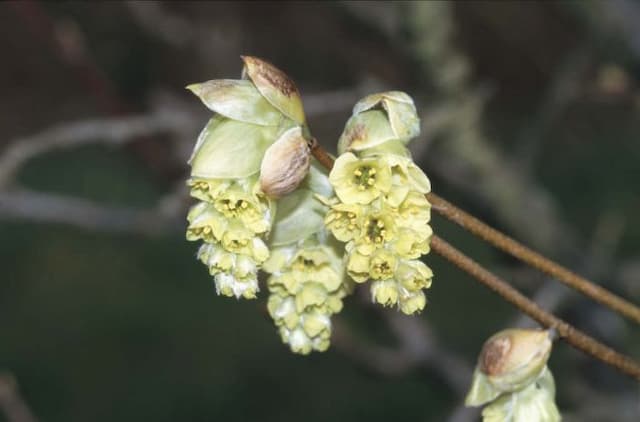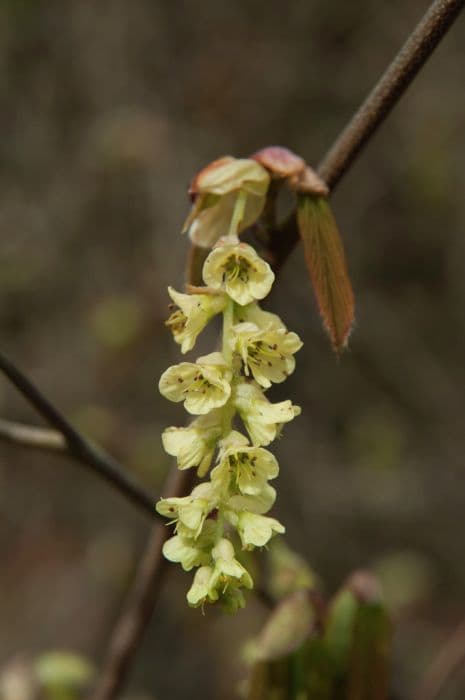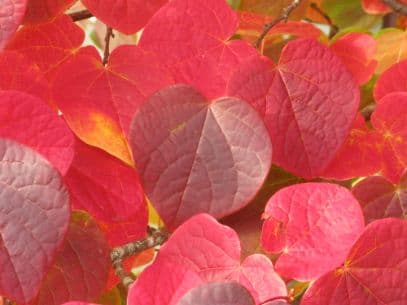Witch Hazel Hamamelis × intermedia 'Harry'

ABOUT
The Witch Hazel 'Harry' is a captivating ornamental shrub that exhibits a distinctive appearance. It boasts a vase-shaped form, with branches that grow in an attractive, somewhat spreading manner. During the winter seasons, this plant is celebrated for its unusual and striking flowers. These blossoms are ribbon-like, with slender, strap-shaped petals that emerge vibrantly before the leaves. The flowers are typically bright yellow with a reddish base, creating a standout display against the backdrop of the bare winter branches. The foliage of the Witch Hazel 'Harry' is also noteworthy, consisting of broadly oval leaves that can offer an appealing texture to the garden throughout the growing season. In the fall, the foliage undergoes a transformation, adopting rich hues that range from yellow to orange and red, providing a spectacular autumnal show. The bark of the plant is smooth and has a greyish tone, lending a subtle beauty to the plant's winter profile. Overall, the Witch Hazel 'Harry' is valued for its seasonal interest, providing color and structure to the garden when other plants have retreated into dormancy.
About this plant
 Names
NamesFamily
Hamamelidaceae
Synonyms
Harry's Intermedia Witch Hazel, Hybrid Witch Hazel
Common names
Hamamelis × intermedia 'Harry'.
 Toxicity
ToxicityTo humans
Witch hazel is not typically considered toxic to humans. Ingesting parts of the plant in large quantities might cause some stomach upset, but significant poisoning is rare. It's widely used in skincare and medical treatments for its astringent properties, but as with any plant, people with certain allergies may have a reaction.
To pets
Witch hazel is also not generally regarded as toxic to pets. However, ingesting the plant in large amounts may result in gastrointestinal upset, such as vomiting or diarrhea in animals. It's always good practice to prevent pets from ingesting plants, as individual animals might have different sensitivities or allergic reactions.
 Characteristics
CharacteristicsLife cycle
Perennials
Foliage type
Deciduous
Color of leaves
Green
Flower color
Yellow
Height
12 feet (3.66 meters)
Spread
12 feet (3.66 meters)
Plant type
Shrub
Hardiness zones
5
Native area
Asia
Benefits
 General Benefits
General Benefits- Ornamental Appeal: 'Harry' provides striking winter flowers when most plants are dormant, with unique ribbon-like petals that add color and interest to the garden.
- Attracts Wildlife: The flowers of 'Harry' are a source of nectar and thus attract pollinators such as bees and butterflies, promoting biodiversity.
- Seasonal Interest: Offering four seasons of interest with flowers in winter, lush green foliage in spring and summer, and vibrant fall color.
- Durable: It is generally robust and has the ability to withstand cold winter temperatures typical of temperate climates.
- Low Maintenance: Requires minimal care once established, making it suitable for gardeners of all skill levels.
- Shade Tolerance: Can grow in partial shade, providing flexibility in garden design and plant placement.
- Drought Resistance: Once established, it has a degree of drought resistance, reducing the need for frequent watering.
- Soil Adaptability: 'Harry' is adaptable to a range of soil types, although it prefers well-drained soils.
- Minimal Pest Issues: Generally resistant to most pests and diseases, reducing the need for chemical treatments.
 Medical Properties
Medical PropertiesThis plant is not used for medical purposes.
 Air-purifying Qualities
Air-purifying QualitiesThis plant is not specifically known for air purifying qualities.
 Other Uses
Other Uses- Photography: The branches of Witch Hazel can be used to create interesting and textural backdrops for macro photography.
- Holiday Decor: Its vibrant yellow flowers can be used to make unique and natural holiday decorations when blooming during late winter.
- Insect Hotel: Dry Witch Hazel branches can be bundled together to create habitats for beneficial insects in the garden.
- Fragrance Extraction: The flowers of Witch Hazel can be used in the production of homemade potpourri due to their subtle fragrance.
- Art Material: The distinct form of Witch Hazel's branches can be used in the creation of botanical prints or eco-dyeing fabrics.
- Craft Projects: With permission, children can collect the seed pods and leaves for school projects or educational nature crafts.
- Dowsing: Some people use the forked branches of Witch Hazel for dowsing, an ancient practice for searching for groundwater.
- Feline Entertainment: Cats might find the springy branches entertaining to play with under supervision.
- Garden Structure: The naturally strong and arching branches can be used in the garden to support other plants as a living trellis.
- Winter Interest: Planting Witch Hazel in a garden provides a splash of color and interest during the winter months, when few other plants are in bloom.
Interesting Facts
 Feng Shui
Feng ShuiThe Witch Hazel is not used in Feng Shui practice.
 Zodiac Sign Compitability
Zodiac Sign CompitabilityThe Witch Hazel is not used in astrology practice.
 Plant Symbolism
Plant Symbolism- Healing: Hamamelis, commonly known as Witch Hazel, is renowned for its medicinal properties, especially its ability to soothe skin irritations and inflammation, representing healing both physically and emotionally.
- Protection: Historically, Witch Hazel was believed to ward off negative energies and offer protection, possibly because its dowsing rods were used to locate water or precious metals.
- Nature's Resilience: Blooming in the middle of winter, Witch Hazel symbolizes the strength and resilience of nature, and the idea that life can flourish even in the harshest conditions.
 Water
WaterWitch hazel 'Harry' prefers evenly moist soil, which usually requires watering once a week with about 1 to 1.5 gallons of water. During hot, dry spells, watering frequency should increase to twice a week. Make sure water penetrates the soil deeply to encourage deep root growth. Reduce the amount of water in winter when the plant is dormant. Overwatering can lead to root rot, so it's important to ensure that the soil drains well after irrigation.
 Light
LightWitch hazel 'Harry' thrives in full sun to partial shade. Positioning the plant in a spot with morning sunlight and afternoon shade often yields the best results. Avoid deep shade as it can reduce flowering and weaken the plant.
 Temperature
TemperatureWitch hazel 'Harry' is hardy and can tolerate a broad range of temperatures, normally from about -10°F to over 100°F. However, it prefers temperate climates with an ideal growing range between 60°F and 75°F.
 Pruning
PruningWitch hazel 'Harry' should be pruned to remove dead or crossed branches and to maintain shape. The ideal time for pruning is immediately after flowering in the spring. Light pruning every year or a more thorough trim every few years will keep the plant healthy and well-shaped.
 Cleaning
CleaningAs needed
 Soil
SoilWitch Hazel 'Harry' prefers well-draining, fertile soil with a slightly acidic to neutral pH, ideally ranging from 5.5 to 7.0. An ideal soil mix can be made with equal parts garden soil, compost, and leaf mold or pine bark for acidity and drainage. Regular mulching can help to maintain soil moisture and structure.
 Repotting
RepottingWitch Hazel 'Harry' does not typically require frequent repotting as it is generally grown as a large shrub or small tree outdoors. Repot young plants only when they outgrow their current container, which may be every few years.
 Humidity & Misting
Humidity & MistingWitch Hazel 'Harry' is adaptable to a range of humidity levels and does not require specific humidity conditions. It can thrive in the natural outdoor humidity but does not need high humidity to grow well.
 Suitable locations
Suitable locationsIndoor
Place in bright, indirect light and ensure pot has good drainage.
Outdoor
Choose sun to part shade; mulch root zone; water regularly.
Hardiness zone
5-8 USDA
 Life cycle
Life cycleHamamelis × intermedia 'Harry', commonly known as Witch Hazel, begins its life cycle with seed germination, which occurs after a period of stratification to overcome dormancy. The seedling stage follows, where the young plant establishes its root system and develops its first set of true leaves. As it enters the vegetative growth phase, the plant focuses on leaf and stem development, gradually maturing over the years. The next significant stage is the flowering period, which notably occurs in late winter to early spring, producing fragrant yellow to red flowers. After pollination, usually by insects, the plant sets seed, enclosed in a capsule that splits open in autumn to disperse seeds, thus completing the cycle. Throughout its life, Witch Hazel may also undergo vegetative reproduction through root suckers, giving rise to new genetically identical plants.
 Propogation
PropogationPropogation time
Late Winter
The Witch Hazel 'Harry' is commonly propagated by softwood cuttings, which is the most popular method for this particular hybrid. The best time for taking softwood cuttings is in late spring to early summer when new growth is still pliable but beginning to mature. To propagate by cuttings, a 4-6 inch long piece of stem should be cut from the parent plant just below a node. The lower leaves are removed, and the cut end is often dipped in rooting hormone to encourage root development. The cutting should then be placed into a well-draining potting mix and kept humid by covering with a plastic bag or using a misting system. Rooting can take several weeks, so patience is essential. Once roots establish and new growth appears, the new plant can be gradually hardened off and eventually transplanted outdoors.
